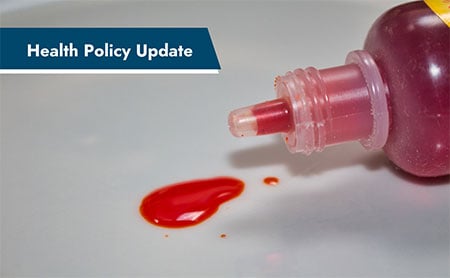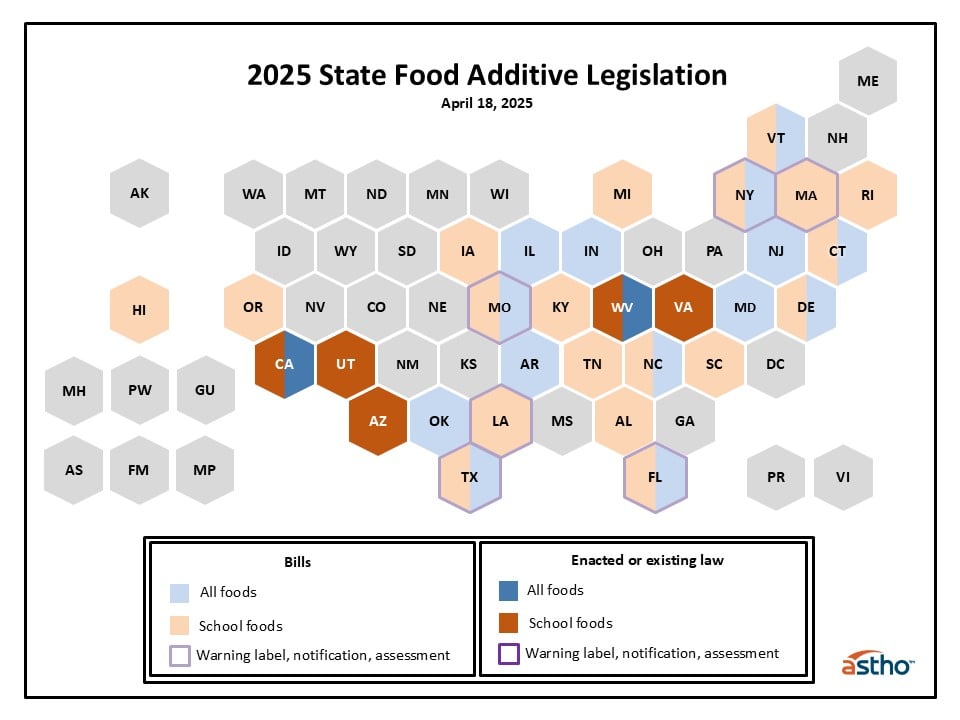States Moving to Prohibit Additives and Dyes in Food
April 29, 2025 | Andy Baker-White

Earlier this year, FDA concluded that data showing a commonly-used dye in foods and drugs, Red No. 3, causes cancer in laboratory animals. This determination classifies the dye as “unsafe” under federal law; FDA revoked the authorizations for using the dye in food and ingested drugs. More recently, FDA announced it would start the process to ban two other colorants in food, Citrus Red No. 2 and Orange B, and work with industry to remove several other dyes used in food.
Several states are also taking steps to ban or limit the use of Red No. 3 and a host of other additives and dyes commonly found in foods. Legislation addressing these additives typically falls into one of three categories: 1. a statewide, universal ban, 2. a ban for foods served or sold at schools or that limit ultra-processed foods in schools, or 3. requiring a warning label / notification of existing additives on food products or establishing legislative commissions to recommend future policies.
Figure 1: 2025 State Food Additive Legislation

In 2023, California became the first state to pass a law that prohibits using certain food additives and dyes in food. Beginning January 1, 2027, AB 418 bans the use of brominated vegetable oil, potassium bromate, propylparaben, and Red No. 3 in any food product for human consumption. A year later, the state passed AB 2316, to remove foods from schools that contain certain dyes (e.g., Blue 1, Blue 2, Green 3, Red 40, Yellow 5, and Yellow 6) by December 31, 2027. Food products containing these dyes may be sold as part of a school event if the sale occurs off of school property or after the school day ends.
This year, four other states started to prohibit selling or serving foods containing certain additives or dyes. Virginia enacted legislation (S 1289 and H 1910) to ban schools from offering or making available foods containing Blue 1, Blue 2, Green 3, Red 3, Red 40, Yellow 5, or Yellow 6 starting July 1, 2027. West Virginia’s new law (HB 2354) — prohibiting food in schools from containing Blue 1, Blue 2, Green 3, Red 3, Red 40, Yellow 5, or Yellow 6 — goes into effect on August 1, 2025. The law allows schools to sell foods that do not comply only as part of school fundraising if the sale is off school property or at least one-half hour after the school day ends. Starting January 1, 2027, West Virginia’s legislation will consider any food to be adulterated if it contains Blue 1, Blue 2, Green 3, Red 3, Red 40, Yellow 5, or Yellow 6.
Beginning May 7, 2025, Utah’s new law (HB 402) will prohibit schools from selling or serving food that contains potassium bromate, propylparaben, Blue 1, Blue 2, Green 3, Red 3, Red 40, Yellow 5, or Yellow 6. There will be exceptions for food provided by parents to their own students, food provided by teachers with parental permission, and items sold in vending machines or as concessions during school-sponsored events or activities. The prohibitions also do not apply to a charter school or school district with 5,500 or fewer students. In Arizona, HB 2164, recently signed by the governor, prohibits schools from providing “ultraprocessed food” (i.e., food containing potassium bromate, propylparaben, titanium dioxide, brominated vegetable oil, Yellow 5, Yellow 6, Blue 1, Blue 2, Green 3, Red 3, Red 40). The bill, which goes into effect at the beginning of the 2026-2027 school year, does allow for a parent or guardian to provide their own student with ultraprocessed food.
In several other states, similar legislation has moved beyond at least one legislative chamber this year. Bills in Arkansas (SB 9) and Maryland (HB 1208) would ban foods containing certain additives, including potassium bromate and propylparaben. A bill in Texas (SB 314) to prohibit certain additives in foods at school, as well as Texas SB 25, which would require warning labels on foods containing certain additive ingredients, made it to the second legislative chamber. In Tennessee (HB 134) and Delaware (SB 69) bills that would prohibit schools from selling or serving foods containing Red 40 moved through the first legislative chamber. Finally, Illinois SB 93, a bill to prohibit food containing potassium bromate or propylparaben, is in the second legislative chamber for consideration.
In total, during the current legislative year, at least 30 states considered bills limiting the use of certain additives and dyes in food products. Twenty six of the bills would prohibit certain additives in any food in the state, 45 bills would ban food additives or dyes in foods served or sold at schools or limit ultra-processed foods in schools, and nine bills would require warning labels or notification of certain additives in food products or establish legislative commissions to make assessments and recommendations about food additives. The bills are also supported by members of both major political parties: Republicans sponsored 34 of the bills, Democrats sponsored 16, and 26 bills are bipartisan.
ASTHO will continue to monitor this public health issue and update its members.